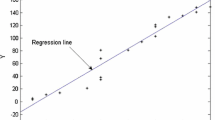Abstract
Many optimization problems that involve practical applications have functional constraints, and some of these constraints are active, meaning that they prevent any solution from improving the objective function value to the one that is better than any solution lying beyond the constraint limits. Therefore, the optimal solution usually lies on the boundary of the feasible region. In order to converge faster when solving such problems, a new ranking and selection scheme is introduced which exploits this feature of constrained problems. In conjunction with selection, a new crossover method is also presented based on three parents. When comparing the results of this new algorithm with six other evolutionary based methods, using 12 benchmark problems from the literature, it shows very encouraging performance. T-tests have been applied in this research to show if there is any statistically significance differences between the algorithms. A study has also been carried out in order to show the effect of each component of the proposed algorithm.
Similar content being viewed by others
References
Mezura-Montes E, Coello C A C. A simple multimembered evolution strategy to solve constrained optimization problems. IEEE Trans. Evolutionary Computation, 2005, 9(1): 1–17.
Barbosa H J C, Lemonge A C C. A new adaptive penalty scheme for genetic algorithms. Inf. Sci., 2003, 156(3): 215–251.
Deb K. An efficient constraint handling method for genetic algorithms. Computer Methods in Applied Mechanics and Engineering, 2000, 186(2–4): 311–338.
Koziel S, Michalewicz Z. Evolutionary algorithms, homomorphous mappings, and constrained parameter optimization. Evolutionary Computation, 1999, 7(1): 19–44.
Farmani R, Wright J A. Self-adaptive fitness formulation for constrained optimization. IEEE Transactions on Evolutionary Computation, 2003, 7(5): 445–455.
Venkatraman S, Yen G G. A generic framework for constrained optimization using genetic algorithms. IEEE Transactions on Evolutionary Computation, 2005, 9(4): 424–435.
Runarsson T P, Yao X. Stochastic ranking for constrained evolutionary optimization. IEEE Transactions on Evolutionary Computation, 2000, 4(3): 284.
Michalewicz Z. Genetic algorithms, numerical optimization, and constraints. In Proc. 6th International Conference on Genetic Algorithms, San Francisco, CA, 1995, pp.151–158.
Sarker R, Kamruzzaman J, Newton C. Evolutionary optimization (EvOpt): A brief review and analysis. International Journal of Computational Intelligence and Applications, 2003, 3(4): 311–330.
Eiben A E, Raué P E, Ruttkay Z. Genetic algorithms with multi-parent recombination. In Proc. 3rd Conference on Parallel Problem Solving from Nature, Jerusalem, 1994, pp.78–87.
Michalewicz Z. Genetic Algorithms + Data Structures = Evolution Programs. 3rd Rev. and Extended Ed, Berlin; New York: Springer-Verlag, 1996.
Zhao X, Gao X S, Hu Z. Evolutionary programming based on non-uniform mutation. MMRC, AMSS, Chinese Academy of Sciences, Beijing, China, December 2004, No.23, pp.352–374.
Sarker R, Newton C. A comparative study of different penalty function-based GAs for constrained optimization. In Proc. the 4th Australia-Japan Joint Workshop on Intelligent and Evolutionary Systems, Japan, 2000.
Runarsson T P, Yao X. Search biases in constrained evolutionary optimization. IEEE Transactions on Systems, Man and Cybernetics, Part C: Applications and Reviews, 2005, 35(2): 233–243.
Elfeky E Z, Sarker R A, Essam D L. A simple ranking and selection for constrained evolutionary optimization. In Proc. 6th International Conf. Simulated Evolution and Learning, Hefei, China, 2006, pp.537–544.
Floudas C A, Pardalos P M. A collection of test problems for constrained global optimization algorithms. Lecture Notes in Computer Science, vol. 455. Berlin: Springer-Verlag, 1990.
Michalewicz Z, Nazhiyath G, Michalewicz M. A note on usefulness of geometrical crossover for numerical optimization problems. In Proc. 5th Annual Conference on Evolutionary Programming, San Diego, CA, 1996, pp.305–312.
Himmelblau D M. Applied Nonlinear Programming. New York: McGraw-Hill, 1972.
Hock W, Schittkowski K. Text Examples for Nonlinear Programming Codes. New York: Springer-Verlag, 1981.
Author information
Authors and Affiliations
Corresponding author
Rights and permissions
About this article
Cite this article
Elfeky, E.Z., Sarker, R.A. & Essam, D.L. Analyzing the Simple Ranking and Selection Process for Constrained Evolutionary Optimization. J. Comput. Sci. Technol. 23, 19–34 (2008). https://doi.org/10.1007/s11390-008-9109-z
Revised:
Published:
Issue Date:
DOI: https://doi.org/10.1007/s11390-008-9109-z




